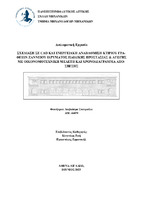| dc.contributor.advisor | KANETAKI, ZOE | |
| dc.contributor.author | Λειβαδάρα, Σταυρούλα | |
| dc.date.accessioned | 2023-09-08T10:15:23Z | |
| dc.date.available | 2023-09-08T10:15:23Z | |
| dc.date.issued | 2023-07-18 | |
| dc.identifier.uri | https://polynoe.lib.uniwa.gr/xmlui/handle/11400/5034 | |
| dc.identifier.uri | http://dx.doi.org/10.26265/polynoe-4872 | |
| dc.description.abstract | Η κλιματική αλλαγή και ενεργειακή κρίση έχουν εντείνει την λήψη άμεσων μέτρων ως προς την εξοικονόμηση ενέργειας και τη μείωση του ανθρακικού αποτυπώματος παγκοσμίως. Ο κτη-ριακός τομέας είναι ένας τους ενεργοβόρους τομείς που συμβάλλουν στην κατάσταση αυτή, με συμμετοχή του 40% της συνολικής κατανάλωσης και του 36% των εκπομπών των αερίων του θερμοκηπίου. Πολιτικές, επιδοτούμενα προγράμματα και καλές πρακτικές επεμβάσεις ενεργειακής αναβάθμισης των υφιστάμενων κτηρίων εφαρμόζονται παγκοσμίως και σε εθνικό επίπεδο για την μείωση της ενεργειακής κατανάλωσης. Το ελληνικό κράτος έχει θέσει ως στόχο την ενεργειακή αναβάθμιση του 12-15% των κτηρίων εντός της επόμενης δεκαετίας, προκειμένου να μειώσει τις καταναλώσεις της πρωτογενούς ενέργειας και τους ρύπους. Επιπλέον, προωθεί την εφαρμογή ανανεώσιμων πηγών ενέργειας και την προστασία του κτηριακού κελύφους μέσω προγραμμάτων. Στο επίκεντρο, εκτός των κατοι-κιών, βρίσκεται πλέον και η ενεργειακή αναβάθμιση κτηρίων του τριτογενούς τομέα, όπως γραφείων. Οι ενεργειακές απαιτήσεις σε αυτό το τομέα αναμένεται να αυξηθούν κατά 26% το 2030 σε σχέση με το 2005. Ιδανικός στόχος είναι όλα τα κτήρια να είναι μηδενικής ενεργειακής κατανάλωσης. Στην παρούσα διπλωματική εργασία αναλύεται η ενεργειακή προφίλ των γραφείων του Ζαννείου Ιδρύματος στην Εκάλη και οι προτάσεις αναβάθμισης του σε μηδενικής κατανάλωσης. Η μεθοδολογία βασίζεται στις τεχνικές οδηγίες του ΤΟΤΕΕ 270710-1/2017 και το πιστοποιημένο λογισμικό ΤΕΕ ΚΕΝΑΚ από το ΥΠΕΚΑ. Το εξεταζόμενο κτήριο υπάγεται σε χαμηλή ενεργειακή κλάση κυρίως λόγω απουσίας θερμομόνωσης, του τύπου των λαμπτήρων και της κατάστασης των Η/Μ συστημάτων του. Τα σενάρια εξοικονόμησης ενέργειας προτάθηκαν βάσει της οικονομικής βιωσιμότητας και των προσδοκώμενων αποτελεσμάτων. Ο συνδυασμός πάνω από μιας επέμβα-σης, όπως προσθήκης θερμομόνωσης του κτηριακού κελύφους με εγκατάσταση φωτοβολταϊκών συστημάτων κλπ, μπορεί να κάνει το κτήριο σε μηδενικής ενεργειακής κατανάλωσης και κλάση (Α++). Ωστόσο, σημαντικός είναι και ο οικονομικός παράγοντας στη λήψη αποφάσεων. Τέλος, γίνεται μια αξιολόγηση των αποτελεσμάτων αναφορικά με το κόστος και τα οφέλη κάθε σεναρίου εξοικονόμησης ενέργειας. | el |
| dc.format.extent | 86 | el |
| dc.language.iso | el | el |
| dc.publisher | Πανεπιστήμιο Δυτικής Αττικής | el |
| dc.rights | Αναφορά Δημιουργού - Μη Εμπορική Χρήση - Παρόμοια Διανομή 4.0 Διεθνές | * |
| dc.rights.uri | https://creativecommons.org/licenses/by-nc-sa/4.0/deed.el | * |
| dc.subject | Ενεργειακή αναβάθμιση | el |
| dc.subject | Ενεργειακή επιθεώρηση | el |
| dc.subject | Λογισμικό ΤΕΕ-ΚΕΝΑΚ | el |
| dc.subject | Εξοικονόμηση ενέργειας | el |
| dc.subject | Γραφεία | el |
| dc.subject | Ενεργειακή μελέτη | el |
| dc.subject | Ενεργειακή κατανάλωση | el |
| dc.subject | Energy upgrade | el |
| dc.subject | Energy consumption | el |
| dc.subject | Energy saving | el |
| dc.subject | Energy study | el |
| dc.subject | Energy inspection | el |
| dc.subject | Office building | el |
| dc.subject | CAD | el |
| dc.title | Σχεδίαση σε CAD και ενεργειακή αναβάθμιση κτηρίου γραφείων Ζαννείου Ιδρύματος Παιδικής Προστασίας & Αγωγής με οικονομοτεχνική μελέτη και χρονοδιάγραμμα απόσβεσης | el |
| dc.title.alternative | Computer aided design (CAD) and upgrade of the energy efficiency of an office building (Ζannio Ιnstitution) with technical and financial study of investment and amortisation schedule | el |
| dc.type | Διπλωματική εργασία | el |
| dc.contributor.committee | Προεστάκης, Εμμανουήλ | |
| dc.contributor.committee | Sarris, Ioannis | |
| dc.contributor.faculty | Σχολή Μηχανικών | el |
| dc.contributor.department | Τμήμα Μηχανολόγων Μηχανικών | el |
| dc.description.abstracttranslated | Climate change and the energy crisis have forced countries to take immediate action to save energy and reduce the carbon footprint worldwide. The building sector is responsible for 40% of the total end-use energy consumption and 36% of the greenhouse gas emissions. Strategies, directives, financial incentives, and best practice interventions for energy upgrading of existing buildings are implemented at global and the national level. The Greek national plan aims to energy upgrade by 12-15% of existing buildings within the next decade (2021-2030) to reduce primary energy consumption and GHGs. Furthermore, the government has established national programs to facilitate the uptake of energy efficiency, promote the implementation of renewable energy sources, and the renovation of the building envelope. The programs do not involve only to residential buildings but also concern the tertiary sector. The estimated energy demand in this sector is expected to be increased by 26% in 2030 compared to 2005. The best scenario is for the existing building to be nearly zero energy consumption buildings (nZEB).
In this thesis, the office building of the Non-government Foundation in Ekali was selected to evaluate its energy profile and propose three energy saving potentials. The final goal is to become a nearly zero energy building. The methodology is a cost-optimal study, based on the technical guidelines of the TOTEE 270710-1/2017 and software TEE KENAK, both approved by the Minis-try of Internal Affairs and Communications. The existing building is in the low energy category due to the lack of thermal insulation, the type of systems, and the condition of its HVAC systems. Energy-saving scenarios were proposed based on economic sustainability and energy-effective results. The combination of more than one action, such as the retrofit of the building envelope with the implementation of photovoltaic systems, can make the building in zero nearly zero energy building (A++). On the other hand, the economic factor is also crucial in decision making. Finally, a benchmarking study on the energy efficiency and financial per energy-saving scenario should take place to give us complete results. | el |


